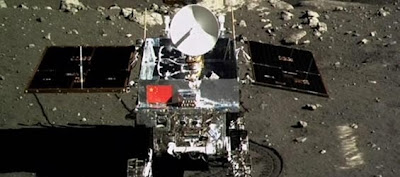The Chang'e 3 lunar lander and moon rover is part of the second phase of China's three-step robotic lunar exploration programhttp://news.xinhuanet.com/english/china/2013-12/15/c_132970100.htm |
Ma Xingrui, chief commander of the lunar program, declared the success of Chang'e-3 mission at the Beijing Aerospace Control Center (BACC), where Chinese President Xi Jinping and Premier Li Keqiang were present.
In a congratulatory message sent by the Communist Party of China Central Committee, the State Council, and the Central Military Commission, the success of Chang'e-3 mission was hailed as a "milestone" in the development of China's space programs, a "new glory" of the Chinese people in their exploration of the frontiers of science and technology and "outstanding contribution" of the Chinese nation in the mankind's peaceful use of the space.
The photographing started at about 11:42 p.m. Beijing Time, when the six-wheeled Yutu moved to a spot about 9 meters north to the lander.
The color images, live transmitted via a deep space network designed by China, showed the Chinese national flag on Yutu. It marked the first time that the five-star red flag had pictures taken in an extraterrestrial body.
After the photographing, the rover and lander embarked on their own scientific explorations. But in the coming days, the two will still have chances of taking photos of each other from different angles while the rover circled the lander.
Yutu will survey the moon's geological structure and surface substances and look for natural resources for three months at a speed of 200 meters per hour, while the lander will conduct in-situ exploration at the landing site for one year.
The 140-kg rover separated from the lander and touched the lunar surface at 4:35 a.m. Sunday, several hours after Chang'e-3 lunar probe soft-landed on the moon's surface at 9:11 p.m. on Saturday.
Chang'e-3 landed on the moon's Sinus Iridum, or the Bay of Rainbows, making China the third country in the world to carry out such a rover mission after the United States and Soviet Union.
This is the world's first soft-landing of a probe on the moon in nearly four decades. The last such soft-landing was carried out by the Soviet Union in 1976.
In ancient Chinese mythology, Yutu was the white pet rabbit of the lunar goddess Chang'e. The name for the rover was selected following an online poll that collected several million votes from people around the world.
The rover, 1.5 meters long with its two wings folded, 1 m in width and 1.1 m in height, is a highly efficient robot controlled by the command center from the earth. It will face challenges including temperature differences of more than 300 degrees Celsius on the moon.
Following the success of the Chang'e-1 and Chang'e-2, respectively launched in 2007 and 2010, the Chang'e-3 lunar probe mission marks the full completion of the second phase of China's lunar program, which includes orbiting, landing and returning to the Earth.
After Chang'e-3, China's lunar program will enter a new stage of unmanned automatic sampling and return.
Wu Weiren, the lunar program's chief designer, said China is likely to bring samples from the moon back to the Earth on an unmanned craft before 2020, paving the way for a manned mission.



No comments:
Post a Comment